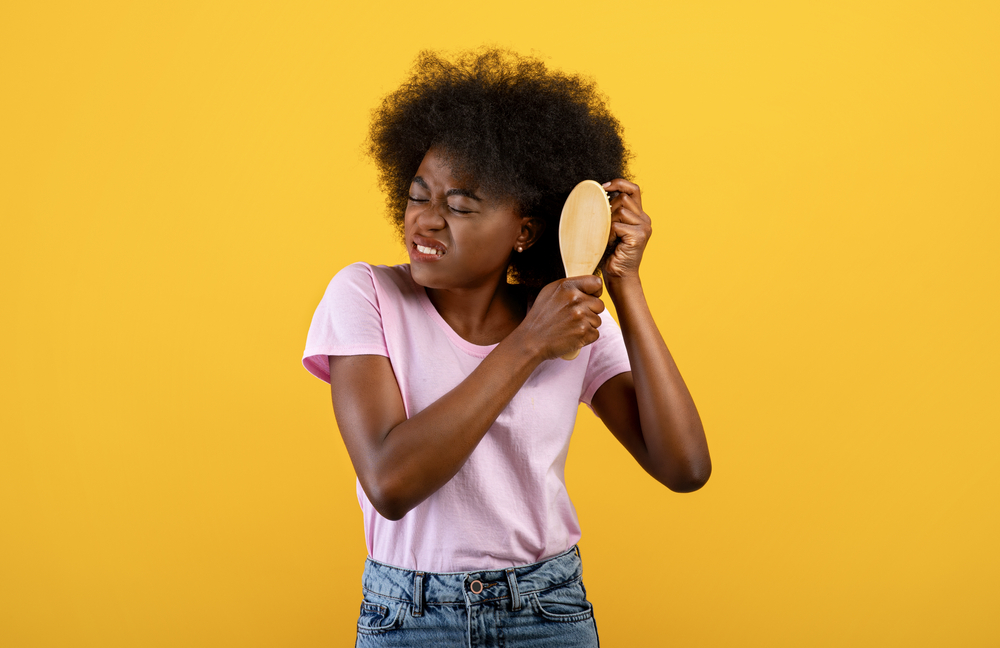Those of us with textured hair know how challenging it can be to prevent tangles from happening, and our curls and coils can become a gnarl magnet if we don’t take the necessary precautions.
In many cases, the occurrence can be so frequent that we may develop a tangle in a single strand—or as the natural hair community prefers to call it, a fairy knot (because a knot of this size could have only been created by a naughty, magical sprite).
According to the International Journal of Trichology, trichonodosis—the technical term for those tiny, single-strand knots— is common for just about everyone. While it can happen spontaneously or by mechanical factors such as vigorous scratching or combing, it tends to occur more frequently in tightly coiled and curly hair types.
Research suggests that African hair was the original of all modern humans prior to African migration, and its characteristics—such as its winding patterns and open density formed by the composition of cortical cells and oval or hooked-shaped follicles—may have initially evolved by way of an adaptive need amongst early humans in Africa to stay cool in hot, sun-scorching climates. As a result, these strands cannot lay flat on a level surface, so when gently pulled and released, they recoil into spirals. This recoiling can lead to an entanglement which, by chance, forms a miniature knot.
Once the hair strand knots, it’s almost impossible to undo, and unfortunately, the only solution to getting rid of it is to cut it off. But before you throw up your hands and surrender to fairy knots, here’s a list of ways you can easily prevent them.
Do a Pre-poo Treatment
As I’m sure most of us know, a pre-shampoo treatment is meant to moisturize the hair before cleansing it. But once it’s pressed and massaged into your strands and ensures they aren’t stripped of oil, it creates a coating that is also great for minimizing the chance of fairy knots forming. Ready-to-use, pre-shampoo treatments are available online and at retail, or you can easily make your own at home with essential oils.
Try to Avoid Combing Through Knots
Although our first instinct may be to grab a comb or brush and go to town on those annoying knots and tangles, doing so could actually make things worse. It only increases the tension that reinforces them, causing undue breakage and damage.
The most effective and least damaging approach is to separate as many strands of hair away from each other as possible by using your fingers. Your index and thumb of each hand are your best tools because they make detangling intuitive. When you’re automatically aware of knots and tangles, you’re more inclined to remove them gently.

Scrubbing Your Ends While Shampooing
If you’re piling your hair onto the top of your head and scrubbing it when you shampoo, then it’s likely you’re creating fairy knots – and split ends.
Our ends are thinner and more porous, so they can’t handle the same amount of friction as our scalp and roots. For this reason, they become more dry, fragile and prone to breakage.
Instead, apply shampoo and scrub only your scalp with your finger pads. As you cleanse and rinse, the shampoo will make its way down and throughout the rest of your hair, providing plenty of cleansing without abrasion and tangling.
Braiding Your Hair Mid-Wash
If keeping your hair under control is a challenge on wash day, then working in braided sections could be a reliable starting point. The method allows you to cleanse and condition without encouraging tangles in the process.
Begin by dividing your hair in half and make about three to four medium-sized braids or twists on both sides, but bear in mind when textured hair is wet, braids tend to hold up better than twists. Of course, do whichever is easiest for you, but if your hair comes undone, then make sure to re-braid or re-twist in order to keep those fairy knots from cropping up.
Slather on the Deep Conditioner
The hydrating qualities of a deep conditioner are highly effective at preventing strands from wrapping around themselves because its weight, emollience and blend of ingredients staves off the friction that causes it. Most are densely formulated with cetrimonium chloride, the clutch ingredient responsible for lubricating hair strands and for providing that great slip we all love. Although it isn’t the sexiest-sounding ingredient, it is one of the hardest-working substances in hair care; not only does it prevent the growth of bacteria and helps to blend other ingredients that wouldn’t normally play nice, but it is a great, all-around smoothing agent and expert detangler.

Make Protective Styling a Priority
As much as we all love a good wash-and-go style, unfortunately, they create the ideal environment for fairy knot formation because when textured hair shrinks, its curves tend to overlap and intersect. Lightly stretching the hair with protective styles like twist-outs, braid-outs, rod sets, bunning and Bantu knots are beneficial.
Get Trims Regularly
The ends of your hair are more fragile and prone to splitting and tangling because they are older than the hair growing from your scalp. Wear and tear from everyday styling can hurt them, so this is not an ideal scenario for keeping fairy knots at bay.
Trimming the ends of your hair every 3 to 4 months is an efficient way to prevent knots, tangles and split ends from happening. The extra TLC is also fantastic at maintaining healthy length retention.
If you think you might forget to schedule regular trims with your hair stylist (yes, please have them professionally done; improper trims lead to more knots and tangles), here’s an easy way to remember: when the seasons change, start planning to book your next trim. Easy peasy!
Sleep in a Silk Bonnet
To this end, there are several ways to prevent fairy knots, but in my opinion, sleeping with a silk (or satin) bonnet is one of the easiest and most practical ways to put a stop to them. I especially love Grace Eleyae’s Silk Twist Turban (graceeleyae.com). It is double-lined in silk, which helps to distribute your hair’s natural oils while you sleep easily.
Silk and satin pillowcases are also great at protecting your hair from lost moisture and tangles. Cotton versions are highly absorbent and can dehydrate strands.








